

Prunus avium Kunzego (Kunzes Kirche) - Cherry Tree
Prunus avium Kunzego (Kunzes Kirche) - Cherry Tree
Prunus avium Kunzego Kunzes Kirche
Wild Cherry, Sweet Cherry, Bird Cherry
This item cannot be shipped to the selected country
Oversize package delivery charge from €6.90
Delivery to Corse prohibited
More information
Schedule delivery date,
and select date in basket
This plant carries a 6 months recovery warranty
More information
We guarantee the quality of our plants for a full growing cycle, and will replace at our expense any plant that fails to recover under normal climatic and planting conditions.
Oversize package: home delivery by special carrier from €6.90 per order..
Express home delivery from €8.90.
Delivery to Corse prohibited: UE law prohibits the import of this plant from mainland France to Corse as part of the fight against Xylella fastidiosa. Please accept our sincere apologies.
More information
Description
The cherry tree (Prunus avium) ‘Kunzego’, also known as Prunus ‘Kunzes Kirche’, is a variety appreciated for its large sweet fruits, its cold and wood disease resistance. Originating from Germany, this variety is perfectly suited to harsh climates. The tree, of medium size, produces beautiful cherries with yellow skin turning bright red, and with very sweet yellow flesh. They are harvested in July. This variety will be pollinated by 'Van' or 'Burlat' cherry trees here.
The Prunus ‘Kunzego’ belongs to the Rosaceae family, like all cherry trees, and derives from the botanical species Prunus avium, originating from temperate regions of Europe. This cultivar was developed in Germany in the 19th century for its resistance and fruit quality. With an upright habit and moderate growth, this cherry tree generally reaches 4 to 5 meters in height at maturity. It is a deciduous medium-sized tree suitable for family gardens or small orchards.
Its white flowers appear in spring, usually in April, forming charming clusters, creating a beautiful flowering display before the foliage emerges. The leaves are alternate, ovate in shape, measuring about 10 to 12 cm long, and turn dark green in summer before changing to yellow in autumn. The large-caliber fruits have yellow skin turning bright red. When fully ripe, they turn a dark red colour. Their light yellow flesh is particularly sweet and juicy. These cherries can be eaten fresh or used for jam. The harvest period lasts 3 to 4 weeks, starting in mid-July and ending in August. This cherry tree is also known for its high resistance to low temperatures (-23°C), as well as its resistance to diseases like Bacterial Canker or Gummosis.
This cherry tree is not self-fertile, it requires pollination by another cherry tree nearby.
The ‘Kunzego’ cherry tree has its place in a fruit and ornamental garden. Its charming spring blossoms and colourful cherries will be appreciated in an orchard or as a standalone specimen in a sunny corner of the garden. It can be paired with other fruit trees like the ‘Reinette Clochard’ apple tree, the ‘Louise Bonne d'Avranches’ pear tree, or with plum trees like ‘Mirabelle de Nancy’. Shrubs like the ‘Noir de Bourgogne’ blackcurrant bush or the ‘Versaillaise’ redcurrant bush will help diversify and stagger harvests.
Report an error about the product description
Plant habit
Fruit
Flowering
Foliage
Botanical data
Prunus
avium
Kunzego Kunzes Kirche
Rosaceae
Wild Cherry, Sweet Cherry, Bird Cherry
Prunus avium 'Kunzego', Prunus avium 'Kunzes Kirche'
Cultivar or hybrid
Other Cherry trees
Planting and care
Easy to grow, the Cherry Tree 'Kunzego' thrives in any type of soil, whether acidic or chalky. It prefers moist, light soils and is sensitive to heavy and clayey soils. Choose a sunny exposure. To limit the risk of late frosts on the flowers, it is recommended to plant the Cherry Tree in a sheltered position, facing west and protected from cold winds in regions prone to spring frosts. Planting is preferably done in autumn. If planting multiple plants, space them 4 to 5 m apart for goblet-trained plants.
Loosen the soil deeply, remove rocks and unwanted weeds. Add some sand to improve drainage. Dig a hole 4 to 5 times the size of the root ball. Keep the subsoil on one side and the topsoil on the other. Mix bonemeal or well-rotted compost or potting soil with the subsoil and pour this mixture into the planting hole. Use a stake. Place the root ball, cover with the topsoil and firm down. Water generously (around 10 L). Tie the stake to the plant, crossing the tie in a figure-eight shape, without touching the trunk.
During cultivation, watering is not necessary except in case of extreme heat. Mulch at the base to retain moisture in summer. Protect your harvest by installing, as desired, a bird net, aluminium foil, or old CDs. In case of aphid infestation, spray water mixed with black soap. To combat cherry fruit fly, set up sticky cardboard traps or pheromone traps as soon as cherries start forming on the tree.
Planting period
Intended location
Care
This item has not been reviewed yet - be the first to leave a review about it.
Haven't found what you were looking for?
Hardiness is the lowest winter temperature a plant can endure without suffering serious damage or even dying. However, hardiness is affected by location (a sheltered area, such as a patio), protection (winter cover) and soil type (hardiness is improved by well-drained soil).

Photo Sharing Terms & Conditions
In order to encourage gardeners to interact and share their experiences, Promesse de fleurs offers various media enabling content to be uploaded onto its Site - in particular via the ‘Photo sharing’ module.
The User agrees to refrain from:
- Posting any content that is illegal, prejudicial, insulting, racist, inciteful to hatred, revisionist, contrary to public decency, that infringes on privacy or on the privacy rights of third parties, in particular the publicity rights of persons and goods, intellectual property rights, or the right to privacy.
- Submitting content on behalf of a third party;
- Impersonate the identity of a third party and/or publish any personal information about a third party;
In general, the User undertakes to refrain from any unethical behaviour.
All Content (in particular text, comments, files, images, photos, videos, creative works, etc.), which may be subject to property or intellectual property rights, image or other private rights, shall remain the property of the User, subject to the limited rights granted by the terms of the licence granted by Promesse de fleurs as stated below. Users are at liberty to publish or not to publish such Content on the Site, notably via the ‘Photo Sharing’ facility, and accept that this Content shall be made public and freely accessible, notably on the Internet.
Users further acknowledge, undertake to have ,and guarantee that they hold all necessary rights and permissions to publish such material on the Site, in particular with regard to the legislation in force pertaining to any privacy, property, intellectual property, image, or contractual rights, or rights of any other nature. By publishing such Content on the Site, Users acknowledge accepting full liability as publishers of the Content within the meaning of the law, and grant Promesse de fleurs, free of charge, an inclusive, worldwide licence for the said Content for the entire duration of its publication, including all reproduction, representation, up/downloading, displaying, performing, transmission, and storage rights.
Users also grant permission for their name to be linked to the Content and accept that this link may not always be made available.
By engaging in posting material, Users consent to their Content becoming automatically accessible on the Internet, in particular on other sites and/or blogs and/or web pages of the Promesse de fleurs site, including in particular social pages and the Promesse de fleurs catalogue.
Users may secure the removal of entrusted content free of charge by issuing a simple request via our contact form.
The flowering period indicated on our website applies to countries and regions located in USDA zone 8 (France, the United Kingdom, Ireland, the Netherlands, etc.)
It will vary according to where you live:
- In zones 9 to 10 (Italy, Spain, Greece, etc.), flowering will occur about 2 to 4 weeks earlier.
- In zones 6 to 7 (Germany, Poland, Slovenia, and lower mountainous regions), flowering will be delayed by 2 to 3 weeks.
- In zone 5 (Central Europe, Scandinavia), blooming will be delayed by 3 to 5 weeks.
In temperate climates, pruning of spring-flowering shrubs (forsythia, spireas, etc.) should be done just after flowering.
Pruning of summer-flowering shrubs (Indian Lilac, Perovskia, etc.) can be done in winter or spring.
In cold regions as well as with frost-sensitive plants, avoid pruning too early when severe frosts may still occur.
The planting period indicated on our website applies to countries and regions located in USDA zone 8 (France, United Kingdom, Ireland, Netherlands).
It will vary according to where you live:
- In Mediterranean zones (Marseille, Madrid, Milan, etc.), autumn and winter are the best planting periods.
- In continental zones (Strasbourg, Munich, Vienna, etc.), delay planting by 2 to 3 weeks in spring and bring it forward by 2 to 4 weeks in autumn.
- In mountainous regions (the Alps, Pyrenees, Carpathians, etc.), it is best to plant in late spring (May-June) or late summer (August-September).
The harvesting period indicated on our website applies to countries and regions in USDA zone 8 (France, England, Ireland, the Netherlands).
In colder areas (Scandinavia, Poland, Austria...) fruit and vegetable harvests are likely to be delayed by 3-4 weeks.
In warmer areas (Italy, Spain, Greece, etc.), harvesting will probably take place earlier, depending on weather conditions.
The sowing periods indicated on our website apply to countries and regions within USDA Zone 8 (France, UK, Ireland, Netherlands).
In colder areas (Scandinavia, Poland, Austria...), delay any outdoor sowing by 3-4 weeks, or sow under glass.
In warmer climes (Italy, Spain, Greece, etc.), bring outdoor sowing forward by a few weeks.











































